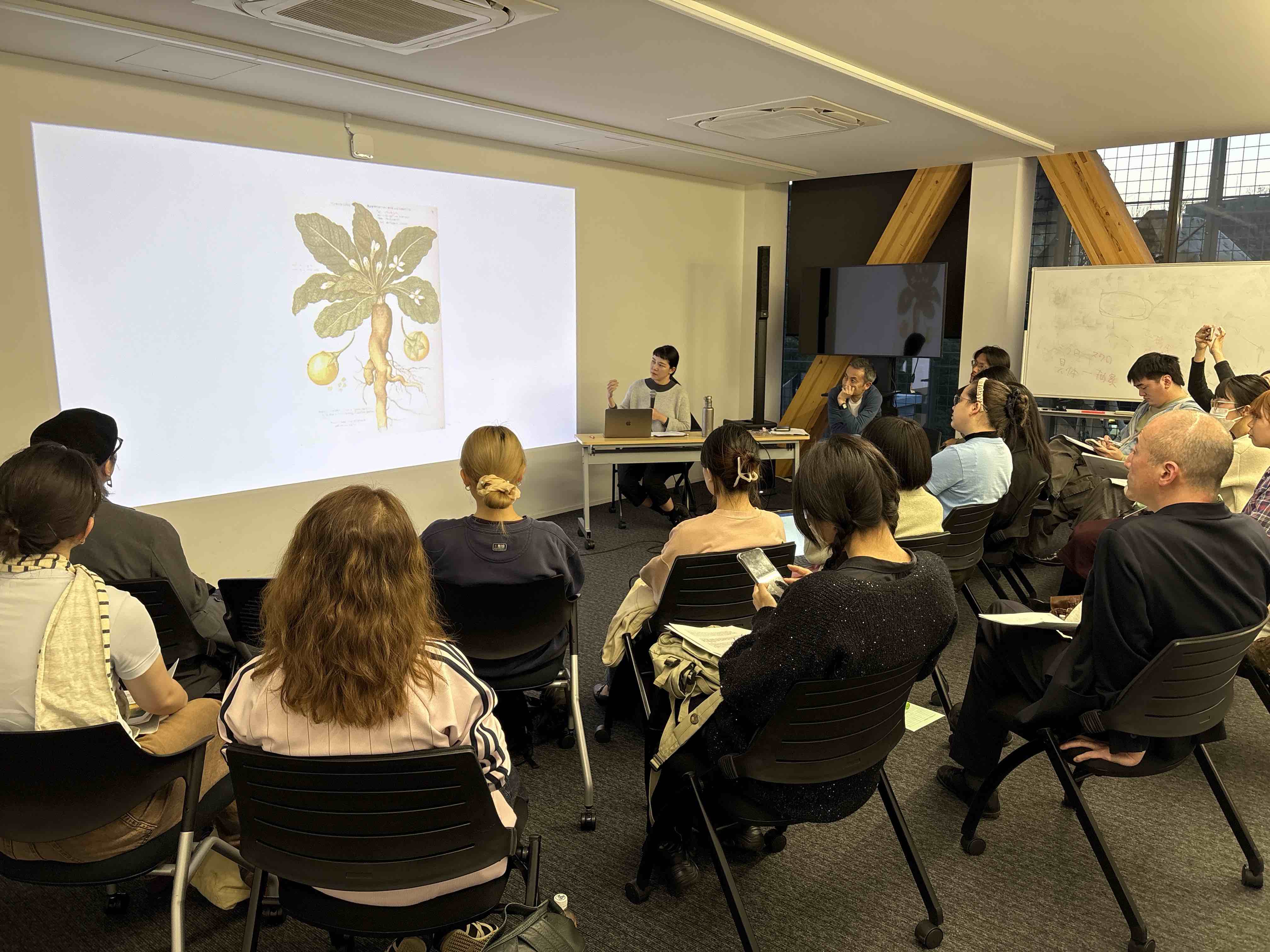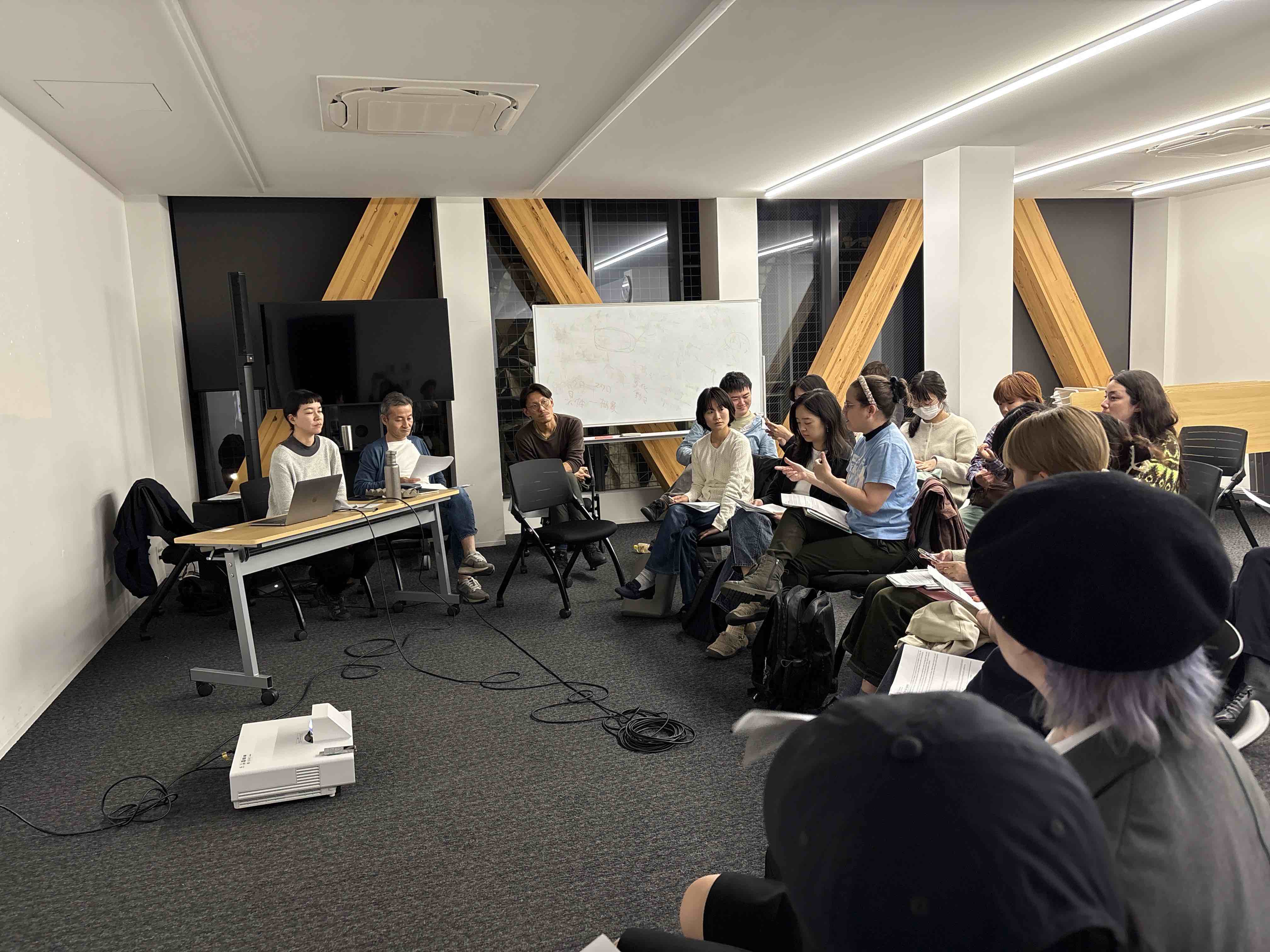2025.06.01
April, 14th, 2025: Report of “Dream Incubation Workshop”

Event Overview
Date: Apr. 14 (Mon.) 6:00-7:30pm
Venue: GA Lecture Room, Hisao & Hiroko TAKI PLAZA 4F, Ueno Campus
Artist: LIU Yu
The “Dream Incubation Workshop” was hosted by the resident artist, Liu Yu at the Ueno Campus of Tokyo University of the Arts. In this workshop, participants brought stories related to mythology and nature, and shared them with the artist and fellow participants through storytelling.
Liu Yu participated in the TEA+ program to conduct research on the "anthropomorphized relationships of plants"in Japan. She has spent her days immersed in intense research, investigating representations that give human traits to plants—such as the mandrake—and traditions of anthropomorphism. After arriving in Japan, she also read parts of Kojiki.
During her research, Liu Yu decided to host a workshop to explore aspects of the “relationship between plants and humans” that are difficult to uncover on her own. The invitation email read:
”We invite each participant to bring a mythological story to share.
This could be your favorite myth, a story connected to nature, or a legend from your place of origin.
The story does not need to be complete —
it might be a bedtime tale once told by a parent,
or a fragment that lingers in your memory from a dream.
Please bring this story with you to the workshop.
Together, we will enter a shared space of dreaming and storytelling.”
Liu Yu set the wide theme of “stories related to mythology” with no restrictions on the form that the stories should take. I also managed to bring a story and participate. But it was puzzling to think about what might qualify as a “story.” I imagine there were other participants who felt the same.
Despite the short notice, an unexpectedly large number of GA and GAP students gathered on the day of the workshop. After Liu Yu briefly shared her research background at the beginning, the workshop moved on to the main part—listening to participants’ stories. Among the 15 students present, the variety of stories shared was truly remarkable: there were not only traditional folktales from Japan and Korea, moral teachings from China, and rumors of spirits from Cuba—but also stories passed on by family members, fragments remembered from dreams, and even original tales created by the students themselves. Liu Yu listened to what the students shared attentively, nodding and taking notes.

Astonishingly, once all students had finished storytelling, Liu Yu offered comments and questions on every story. To a student who presented the Japanese anecdote of “Tobiume”—the tale of a plum tree that flew to Kyushu to reunite with its exiled master, Sugawara no Michizane—she remarked:
“It’s fascinating that the plant followed its master driven by emotion.”
Then added that relationships between plants and human emotions often seem to be treated as taboo. The student, whose major is Japanese classical dance, mentioned that there is a dance piece based on “Tobiume” and the important point is how emotionally they perform the plum tree. It was rare to hear about such a topic, so some participants reacted with surprise.
I brought a local story from my hometown, about a shrine that keeps chickens said to be descendants of a sacred bird appearing in Japanese mythology. Liu Yu seemed especially intrigued by the fact that a shrine would keep chickens, asking:
“Do they really keep chickens?”
“Why do they keep them?”
She asked me questions so eagerly that I thought maybe I should have researched this more.
As Liu Yu continued engaging in dialogue with each student, the atmosphere gradually softened. It was a safe space where reactions freely arose while listening to others. One student suggested the topic:
“The motifs of water and women often appear together in spiritual stories.”
From there, the workshop transitioned into an open discussion until the end.
Two aspects of the workshop left a strong impression on me. First, many students genuinely enjoyed the workshop.This was evident from the fact that nearly 30 people were present, including observers. I think mythology, folklore…such “slightly mysterious stories” are things everyone can find interesting in their own way. The workshop had the capacity to accommodate a wide range of interests—from “want to listen” to “want to tell.” While I initially felt that the scope of “story” was too broad, this openness let students engage and eventually allowed them to observe the ways objects and characters in mythological stories are accepted and interpreted.
The workshop also showed that stories tied to myth and legend are often deeply connected to nationality or personal identity. GA and GAP have many international students, and many of them participated in the workshop. There was one student who shared her story with great passion. As she spoke, she added detailed explanations about the natural environment and cultural beliefs of their country, in whose sacredness and awe the mythological figures root. It was fascinating to watch how the students added contexts to adapt the story so that others—who might be culturally distant from it—could understand.

Having participated, I realized how challenging the workshop’s central task was: to shape a story into a form that others could understand. Regardless of the format, explaining a story requires not only thinking about whose perspective the story is told from but also considering the relationship between the original perspective and “me” (the storyteller at the workshop). Sharing a story you know from before with others is more demanding than expected—it becomes a task of conveying a narrative. By telling a story, I was also sharing how I understand that story.
That’s why, when the open discussion unfolded at the end of the “Dream Incubation Workshop,” I was both surprised and somehow convinced. It was precisely because each participant had carefully listened to each other’s narrative that they could move into exchanging across different cultural backgrounds. The word “incubation” means care for something being born. Just as Liu Yu suggested, perhaps we were unconsciously nurturing a common dream together.
Liu Yu’s work centers on nature, anthropomorphism, and narratives. I look forward to seeing the artwork she will “incubate” from this workshop.
Author: Asuka Taniguchi (GA master's student)
Project Coordinator: Qiuyu JIN (GA PhD student)
Profile

LIU Yu
Born in 1985, Taiwan. Liu Yu is a visual artist whose creative mediums primarily consist of video and spatial installations. She developed a series of field studies of documentary nature as a kind of working methodology for her artistic practice, prompting her to reorganize interconnected narratives. Through integrating fragmented segments of space, history, imagery, and storytelling, she undertakes some integrative project that establishes close connections and supplements the narratives. Recent solo exhibitions include “Ladies” at the National Taiwan Museum of Fine Arts (2023) and “If Narratives Become the Great Flood” at Hong Foundation/Project Seek (2020). The group shows include “Expeditionary Botanics” at Long March Space in Beijing (2024), The Brooklyn Rail Industry City in New York (2023), “Aqua Paradiso” at ACC in Gwangju (2022), “Asian Art Biennial: Phantasmapolis” at the National Taiwan Museum of Fine Arts (2021).
- Participants
- LIU Yu
- Date
- 2025.06.01